JEEP RENEGADE 2015 1.G Owners Manual
Manufacturer: JEEP, Model Year: 2015, Model line: RENEGADE, Model: JEEP RENEGADE 2015 1.GPages: 678, PDF Size: 29.84 MB
Page 331 of 678
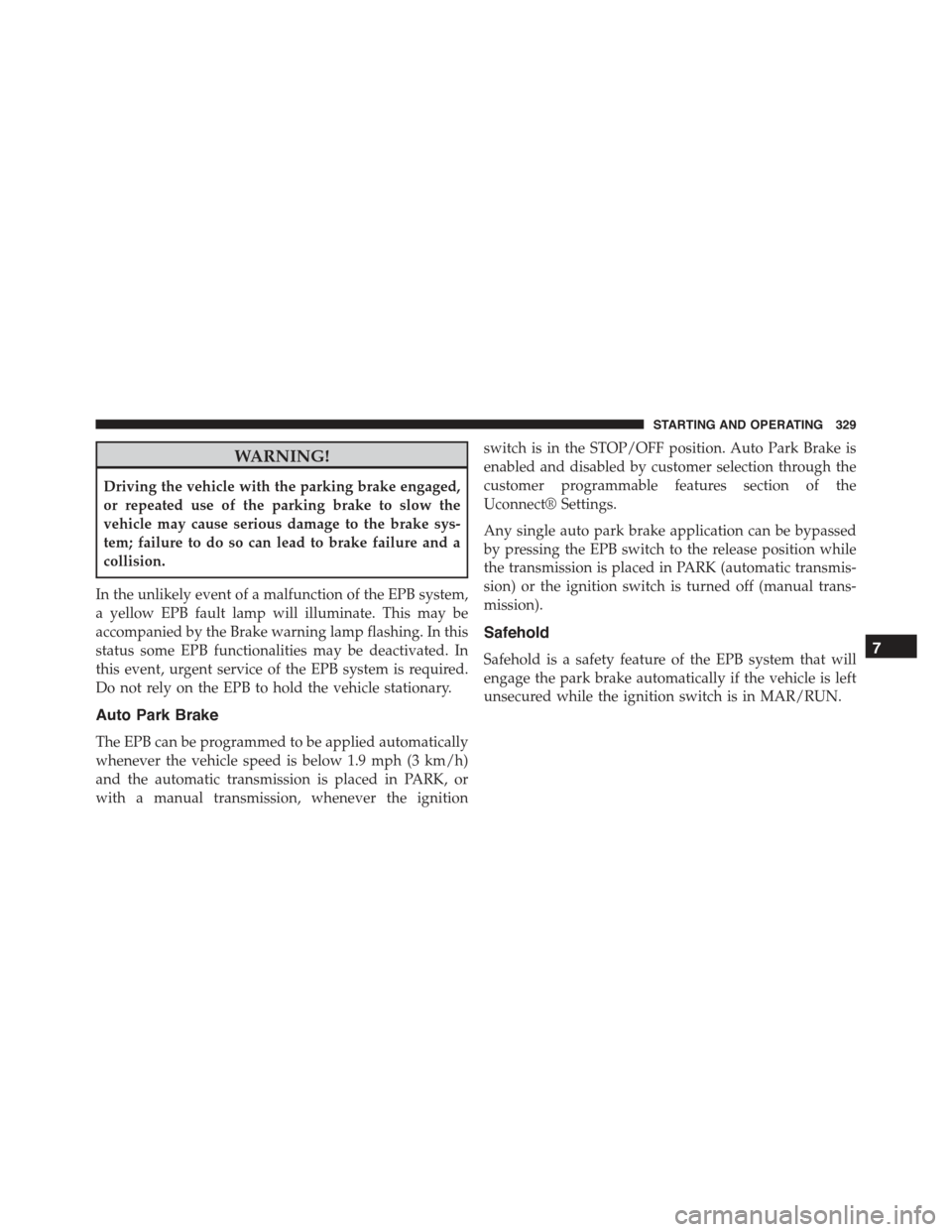
WARNING!
Driving the vehicle with the parking brake engaged,
or repeated use of the parking brake to slow the
vehicle may cause serious damage to the brake sys-
tem; failure to do so can lead to brake failure and a
collision.
In the unlikely event of a malfunction of the EPB system,
a yellow EPB fault lamp will illuminate. This may be
accompanied by the Brake warning lamp flashing. In this
status some EPB functionalities may be deactivated. In
this event, urgent service of the EPB system is required.
Do not rely on the EPB to hold the vehicle stationary.
Auto Park Brake
The EPB can be programmed to be applied automatically
whenever the vehicle speed is below 1.9 mph (3 km/h)
and the automatic transmission is placed in PARK, or
with a manual transmission, whenever the ignition
switch is in the STOP/OFF position. Auto Park Brake is
enabled and disabled by customer selection through the
customer programmable features section of the
Uconnect® Settings.
Any single auto park brake application can be bypassed
by pressing the EPB switch to the release position while
the transmission is placed in PARK (automatic transmis-
sion) or the ignition switch is turned off (manual trans-
mission).
Safehold
Safehold is a safety feature of the EPB system that will
engage the park brake automatically if the vehicle is left
unsecured while the ignition switch is in MAR/RUN.
7
STARTING AND OPERATING 329
Page 332 of 678
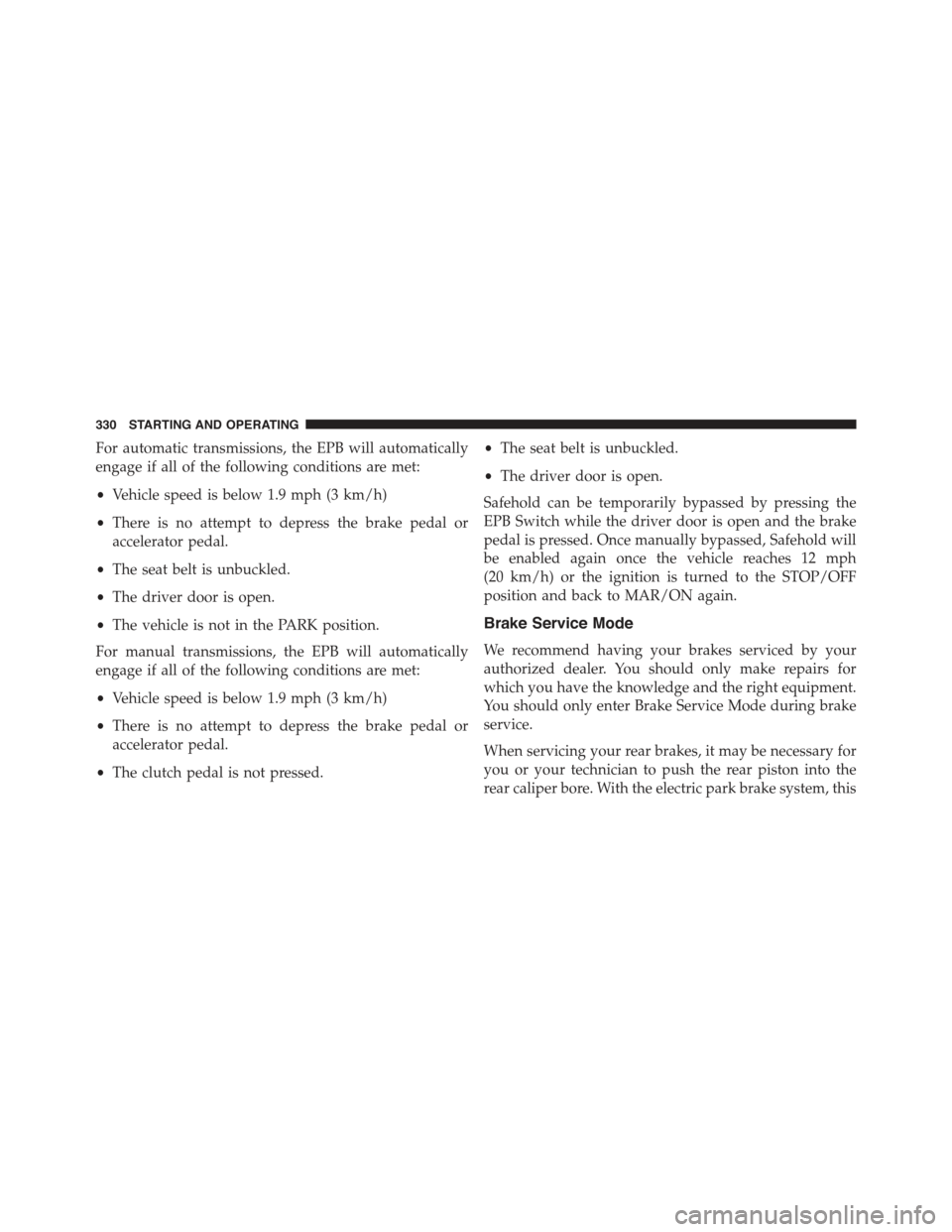
For automatic transmissions, the EPB will automatically
engage if all of the following conditions are met:
•Vehicle speed is below 1.9 mph (3 km/h)
•There is no attempt to depress the brake pedal or
accelerator pedal.
•The seat belt is unbuckled.
•The driver door is open.
•The vehicle is not in the PARK position.
For manual transmissions, the EPB will automatically
engage if all of the following conditions are met:
•Vehicle speed is below 1.9 mph (3 km/h)
•There is no attempt to depress the brake pedal or
accelerator pedal.
•The clutch pedal is not pressed.
•The seat belt is unbuckled.
•The driver door is open.
Safehold can be temporarily bypassed by pressing the
EPB Switch while the driver door is open and the brake
pedal is pressed. Once manually bypassed, Safehold will
be enabled again once the vehicle reaches 12 mph
(20 km/h) or the ignition is turned to the STOP/OFF
position and back to MAR/ON again.
Brake Service Mode
We recommend having your brakes serviced by your
authorized dealer. You should only make repairs for
which you have the knowledge and the right equipment.
You should only enter Brake Service Mode during brake
service.
When servicing your rear brakes, it may be necessary for
you or your technician to push the rear piston into the
rear caliper bore. With the electric park brake system, this
330 STARTING AND OPERATING
Page 333 of 678
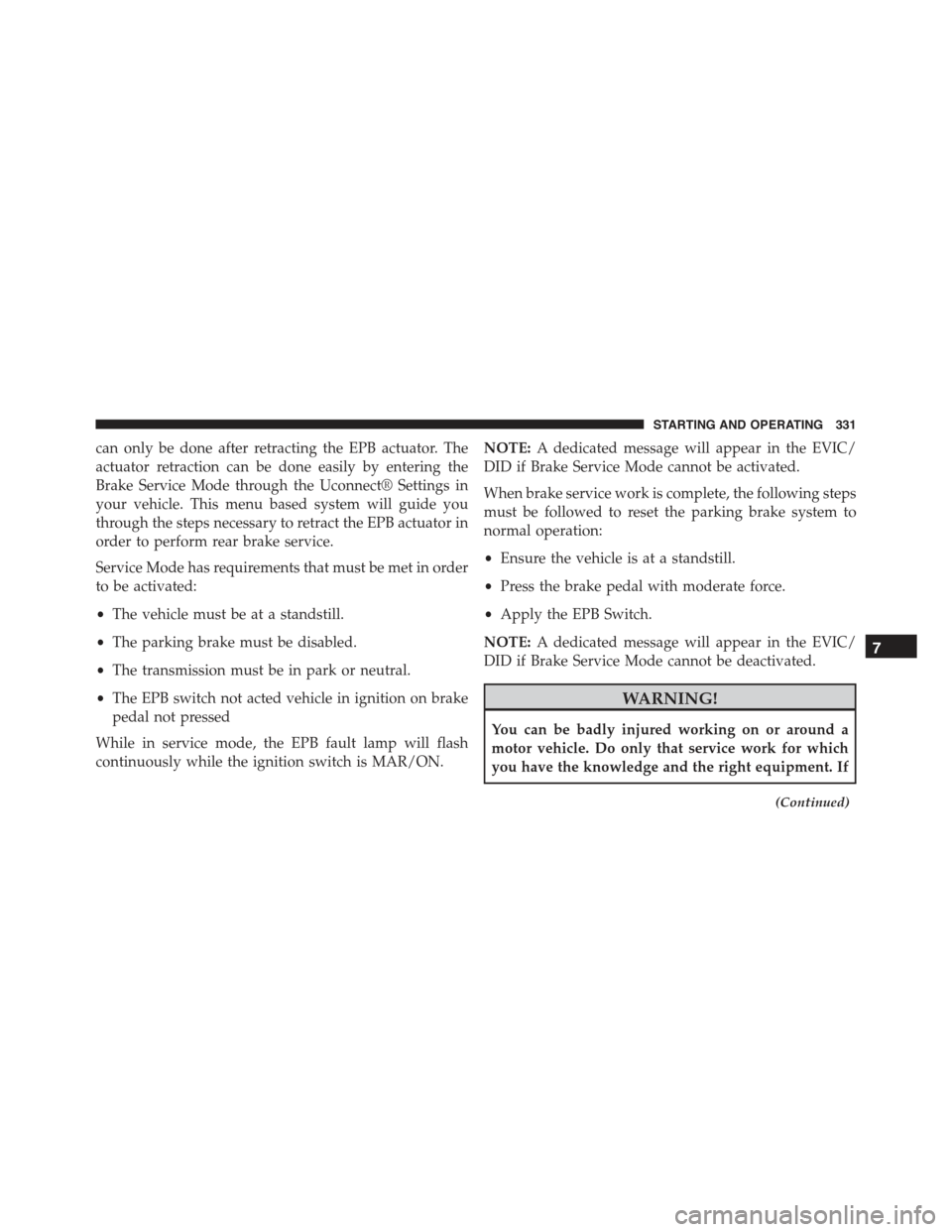
can only be done after retracting the EPB actuator. The
actuator retraction can be done easily by entering the
Brake Service Mode through the Uconnect® Settings in
your vehicle. This menu based system will guide you
through the steps necessary to retract the EPB actuator in
order to perform rear brake service.
Service Mode has requirements that must be met in order
to be activated:
•The vehicle must be at a standstill.
•The parking brake must be disabled.
•The transmission must be in park or neutral.
•The EPB switch not acted vehicle in ignition on brake
pedal not pressed
While in service mode, the EPB fault lamp will flash
continuously while the ignition switch is MAR/ON.
NOTE:A dedicated message will appear in the EVIC/
DID if Brake Service Mode cannot be activated.
When brake service work is complete, the following steps
must be followed to reset the parking brake system to
normal operation:
•Ensure the vehicle is at a standstill.
•Press the brake pedal with moderate force.
•Apply the EPB Switch.
NOTE:A dedicated message will appear in the EVIC/
DID if Brake Service Mode cannot be deactivated.
WARNING!
You can be badly injured working on or around a
motor vehicle. Do only that service work for which
you have the knowledge and the right equipment. If
(Continued)
7
STARTING AND OPERATING 331
Page 334 of 678
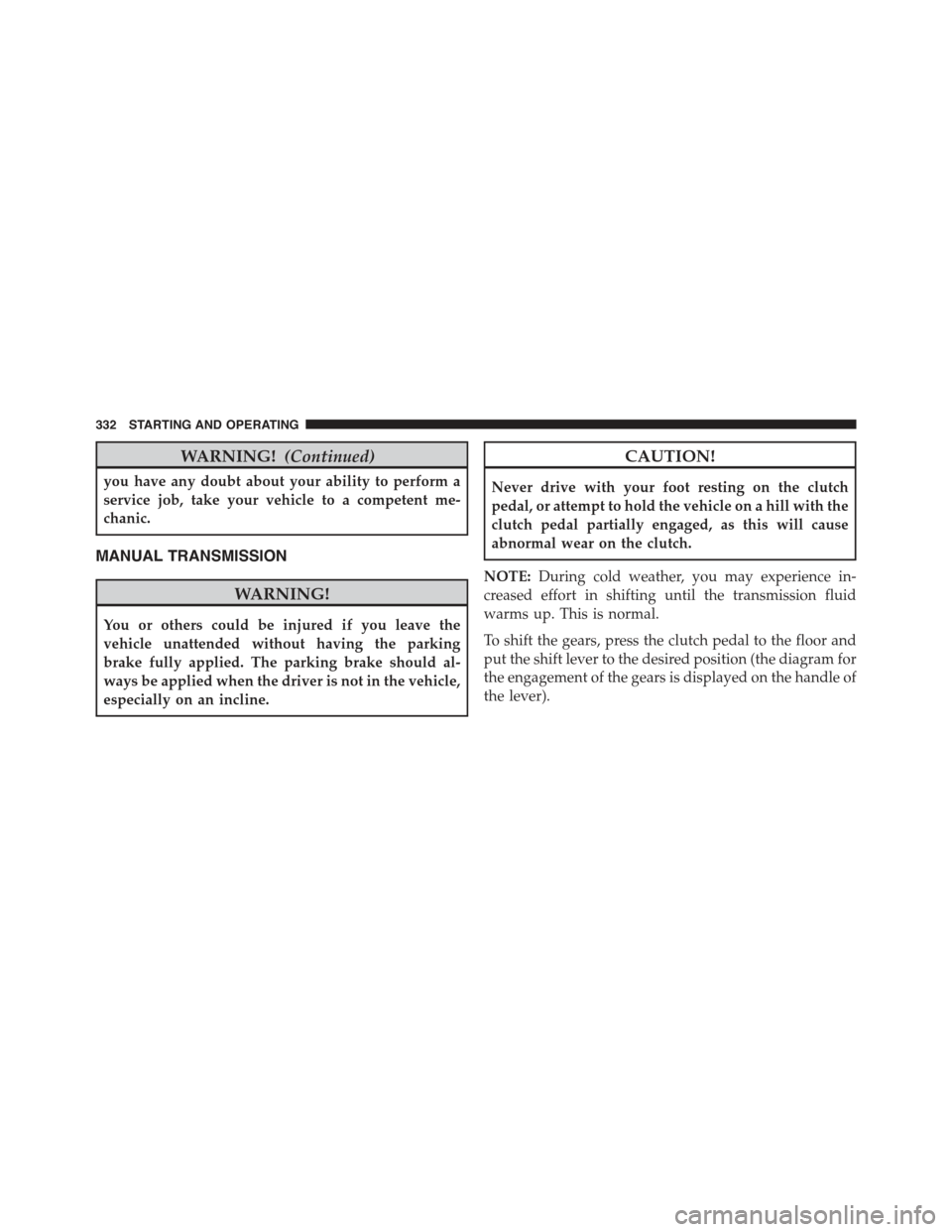
WARNING!(Continued)
you have any doubt about your ability to perform a
service job, take your vehicle to a competent me-
chanic.
MANUAL TRANSMISSION
WARNING!
You or others could be injured if you leave the
vehicle unattended without having the parking
brake fully applied. The parking brake should al-
ways be applied when the driver is not in the vehicle,
especially on an incline.
CAUTION!
Never drive with your foot resting on the clutch
pedal, or attempt to hold the vehicle on a hill with the
clutch pedal partially engaged, as this will cause
abnormal wear on the clutch.
NOTE:During cold weather, you may experience in-
creased effort in shifting until the transmission fluid
warms up. This is normal.
To shift the gears, press the clutch pedal to the floor and
put the shift lever to the desired position (the diagram for
the engagement of the gears is displayed on the handle of
the lever).
332 STARTING AND OPERATING
Page 335 of 678
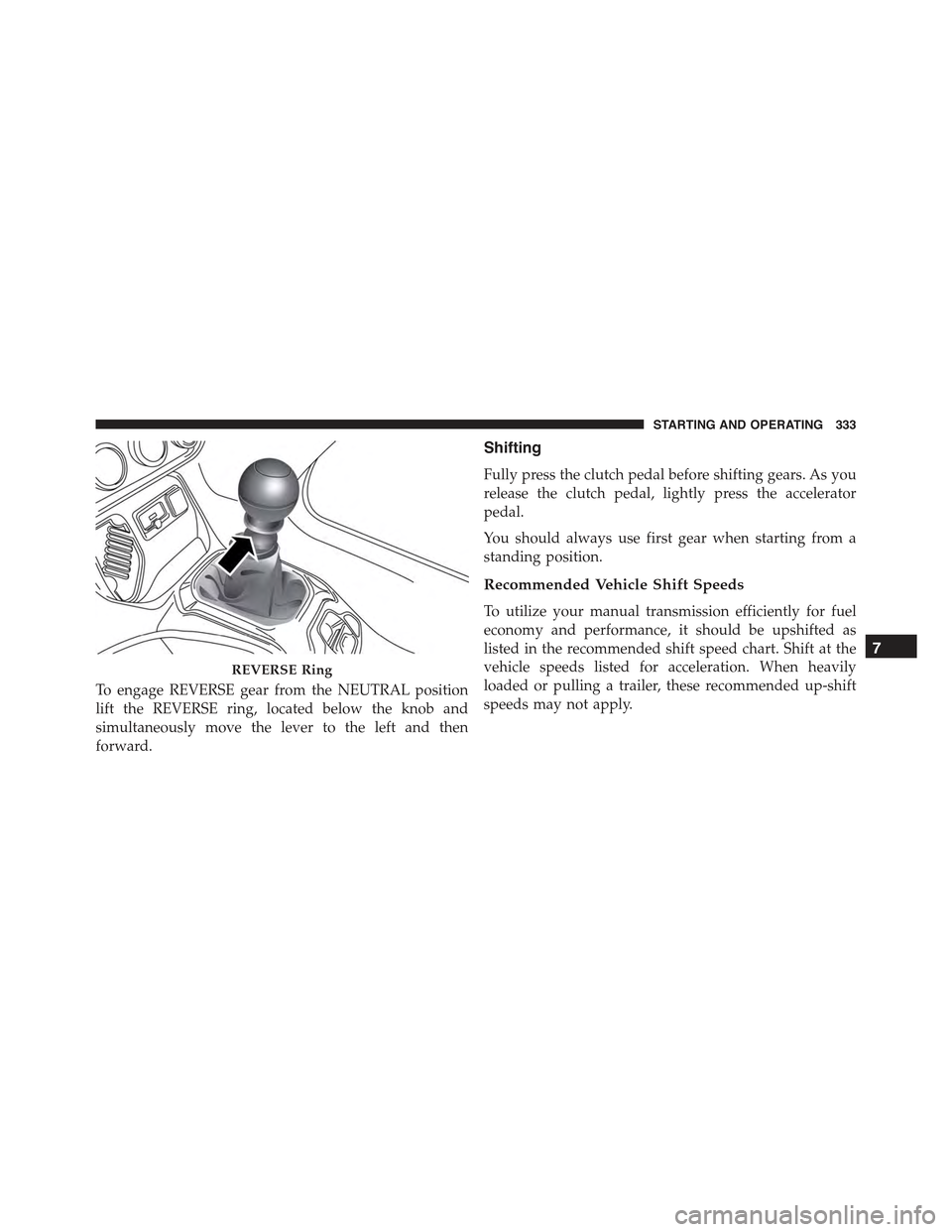
To engage REVERSE gear from the NEUTRAL position
lift the REVERSE ring, located below the knob and
simultaneously move the lever to the left and then
forward.
Shifting
Fully press the clutch pedal before shifting gears. As you
release the clutch pedal, lightly press the accelerator
pedal.
You should always use first gear when starting from a
standing position.
Recommended Vehicle Shift Speeds
To utilize your manual transmission efficiently for fuel
economy and performance, it should be upshifted as
listed in the recommended shift speed chart. Shift at the
vehicle speeds listed for acceleration. When heavily
loaded or pulling a trailer, these recommended up-shift
speeds may not apply.
REVERSE Ring
7
STARTING AND OPERATING 333
Page 336 of 678
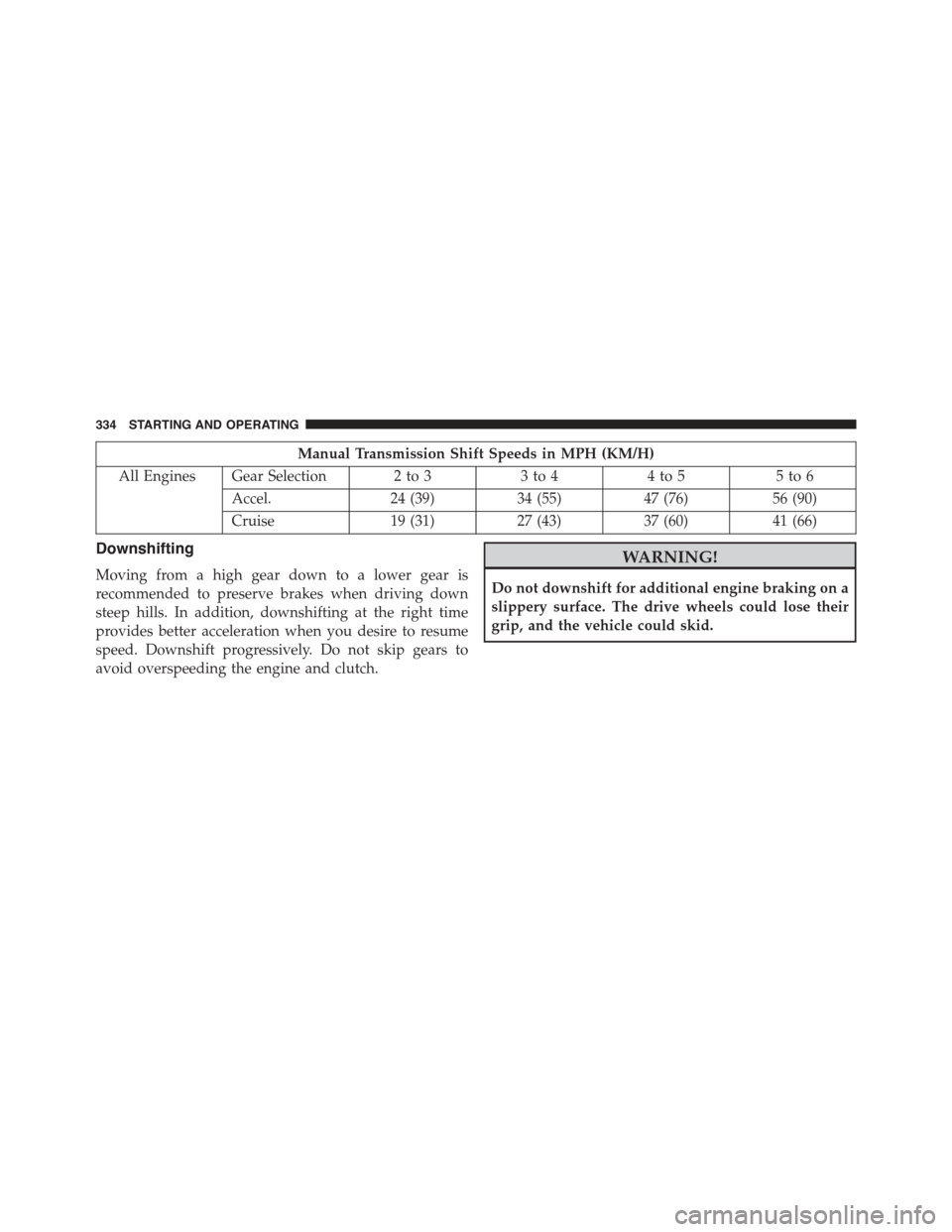
Manual Transmission Shift Speeds in MPH (KM/H)
All Engines Gear Selection 2 to 33 to 44 to 55 to 6
Accel.24 (39)34 (55)47 (76)56 (90)
Cruise19 (31)27 (43)37 (60)41 (66)
Downshifting
Moving from a high gear down to a lower gear is
recommended to preserve brakes when driving down
steep hills. In addition, downshifting at the right time
provides better acceleration when you desire to resume
speed. Downshift progressively. Do not skip gears to
avoid overspeeding the engine and clutch.
WARNING!
Do not downshift for additional engine braking on a
slippery surface. The drive wheels could lose their
grip, and the vehicle could skid.
334 STARTING AND OPERATING
Page 337 of 678
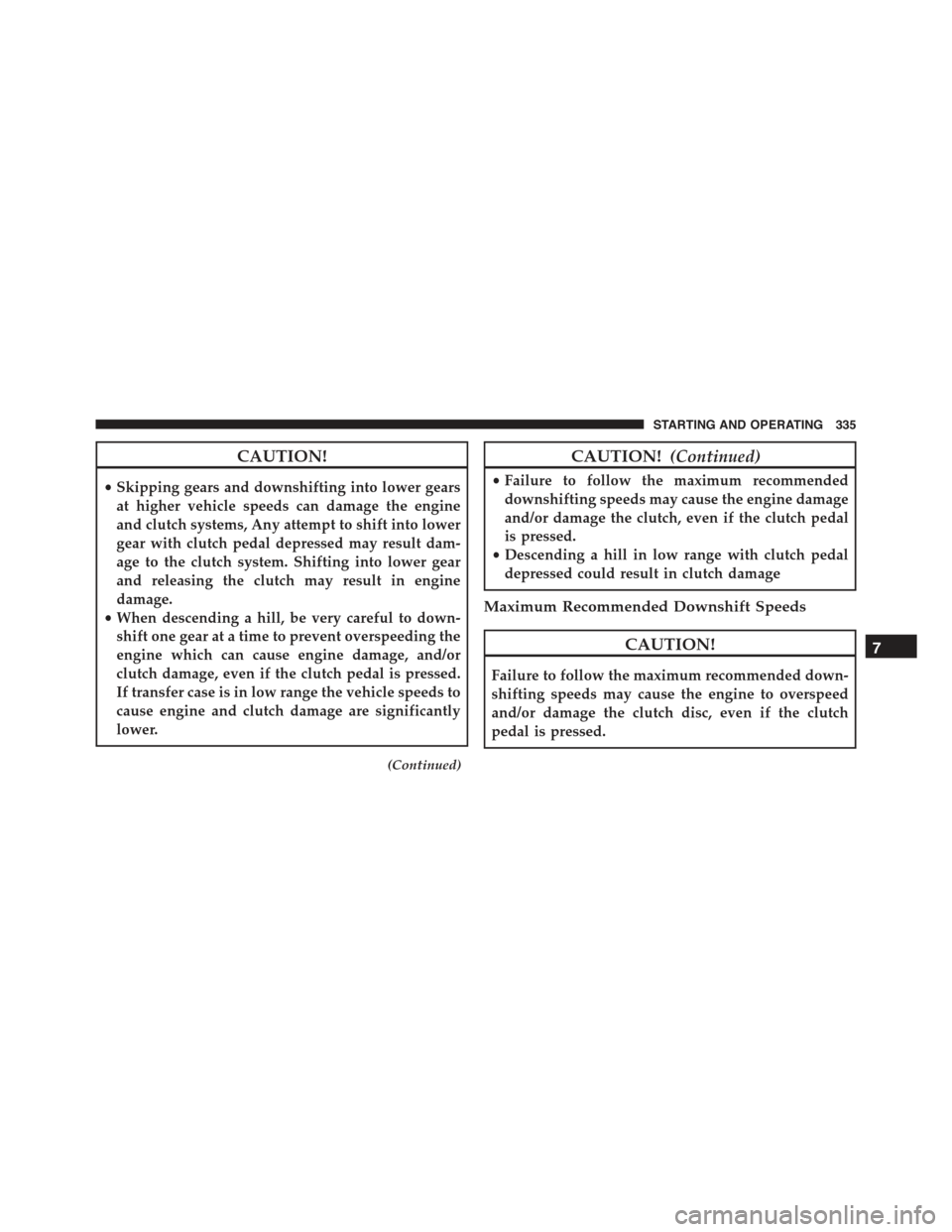
CAUTION!
•Skipping gears and downshifting into lower gears
at higher vehicle speeds can damage the engine
and clutch systems, Any attempt to shift into lower
gear with clutch pedal depressed may result dam-
age to the clutch system. Shifting into lower gear
and releasing the clutch may result in engine
damage.
•When descending a hill, be very careful to down-
shift one gear at a time to prevent overspeeding the
engine which can cause engine damage, and/or
clutch damage, even if the clutch pedal is pressed.
If transfer case is in low range the vehicle speeds to
cause engine and clutch damage are significantly
lower.
(Continued)
CAUTION!(Continued)
•Failure to follow the maximum recommended
downshifting speeds may cause the engine damage
and/or damage the clutch, even if the clutch pedal
is pressed.
•Descending a hill in low range with clutch pedal
depressed could result in clutch damage
Maximum Recommended Downshift Speeds
CAUTION!
Failure to follow the maximum recommended down-
shifting speeds may cause the engine to overspeed
and/or damage the clutch disc, even if the clutch
pedal is pressed.
7
STARTING AND OPERATING 335
Page 338 of 678
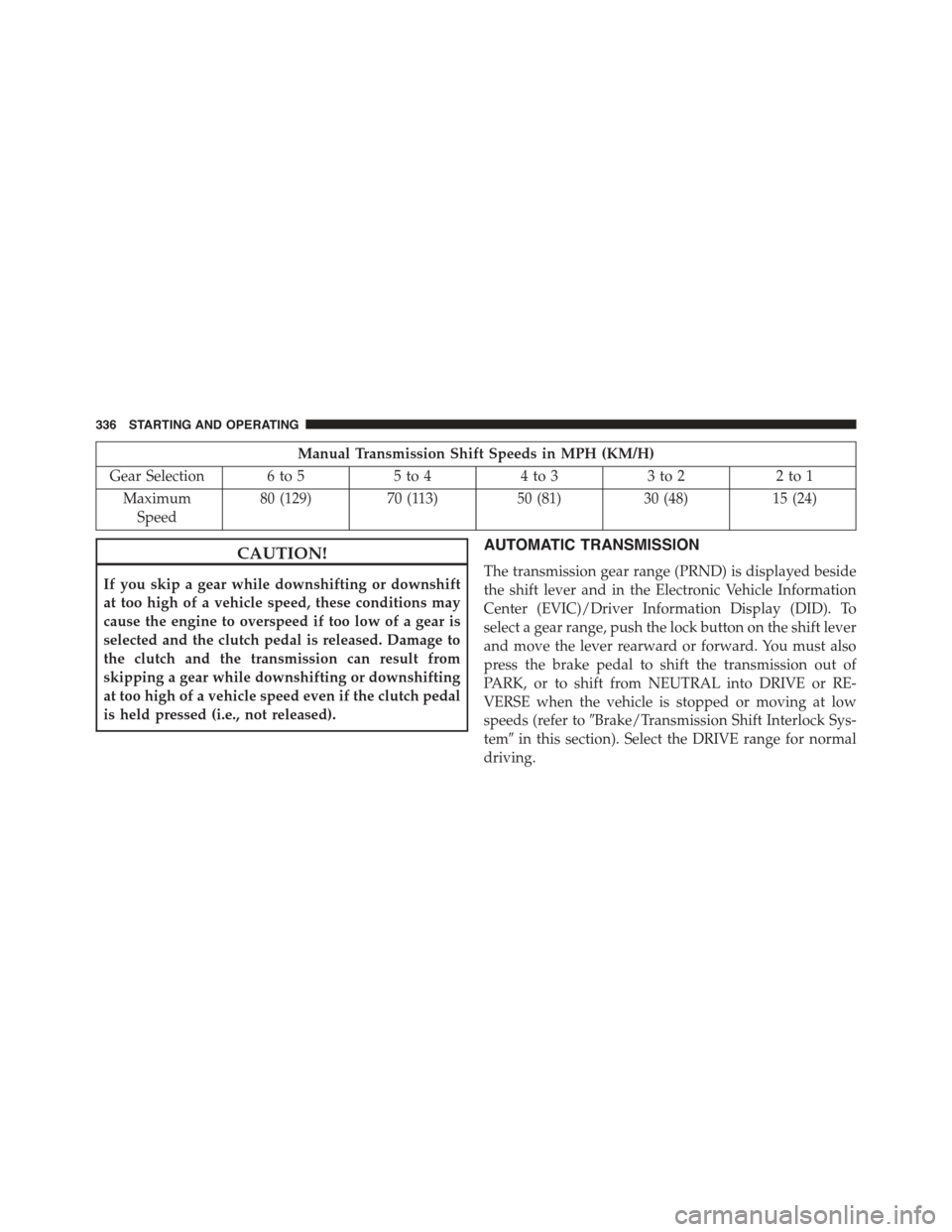
Manual Transmission Shift Speeds in MPH (KM/H)
Gear Selection 6 to 55 to 44 to 33 to 22 to 1
Maximum
Speed
80 (129)70 (113)50 (81)30 (48)15 (24)
CAUTION!
If you skip a gear while downshifting or downshift
at too high of a vehicle speed, these conditions may
cause the engine to overspeed if too low of a gear is
selected and the clutch pedal is released. Damage to
the clutch and the transmission can result from
skipping a gear while downshifting or downshifting
at too high of a vehicle speed even if the clutch pedal
is held pressed (i.e., not released).
AUTOMATIC TRANSMISSION
The transmission gear range (PRND) is displayed beside
the shift lever and in the Electronic Vehicle Information
Center (EVIC)/Driver Information Display (DID). To
select a gear range, push the lock button on the shift lever
and move the lever rearward or forward. You must also
press the brake pedal to shift the transmission out of
PARK, or to shift from NEUTRAL into DRIVE or RE-
VERSE when the vehicle is stopped or moving at low
speeds (refer to#Brake/Transmission Shift Interlock Sys-
tem#in this section). Select the DRIVE range for normal
driving.
336 STARTING AND OPERATING
Page 339 of 678
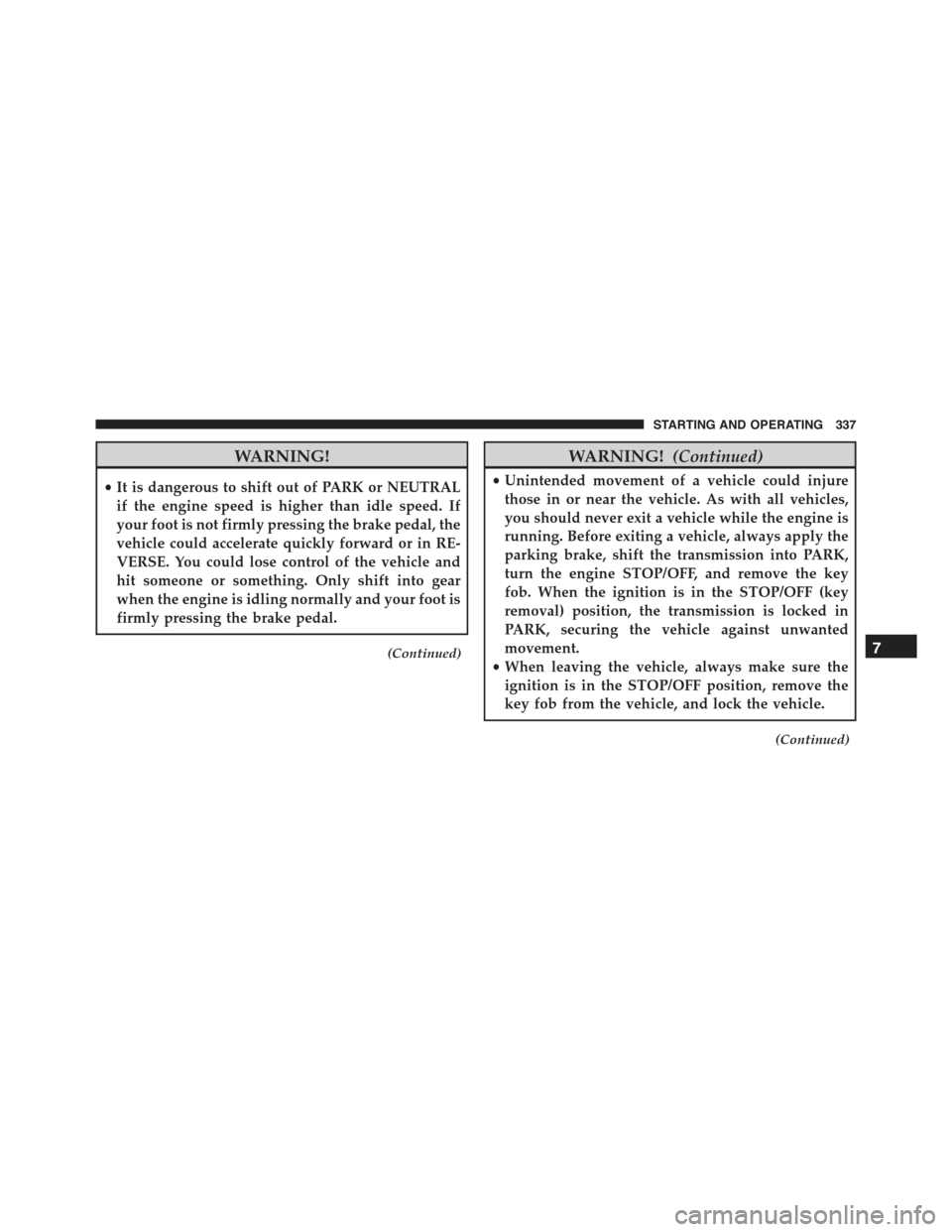
WARNING!
•It is dangerous to shift out of PARK or NEUTRAL
if the engine speed is higher than idle speed. If
your foot is not firmly pressing the brake pedal, the
vehicle could accelerate quickly forward or in RE-
VERSE. You could lose control of the vehicle and
hit someone or something. Only shift into gear
when the engine is idling normally and your foot is
firmly pressing the brake pedal.
(Continued)
WARNING!(Continued)
•Unintended movement of a vehicle could injure
those in or near the vehicle. As with all vehicles,
you should never exit a vehicle while the engine is
running. Before exiting a vehicle, always apply the
parking brake, shift the transmission into PARK,
turn the engine STOP/OFF, and remove the key
fob. When the ignition is in the STOP/OFF (key
removal) position, the transmission is locked in
PARK, securing the vehicle against unwanted
movement.
•When leaving the vehicle, always make sure the
ignition is in the STOP/OFF position, remove the
key fob from the vehicle, and lock the vehicle.
(Continued)
7
STARTING AND OPERATING 337
Page 340 of 678
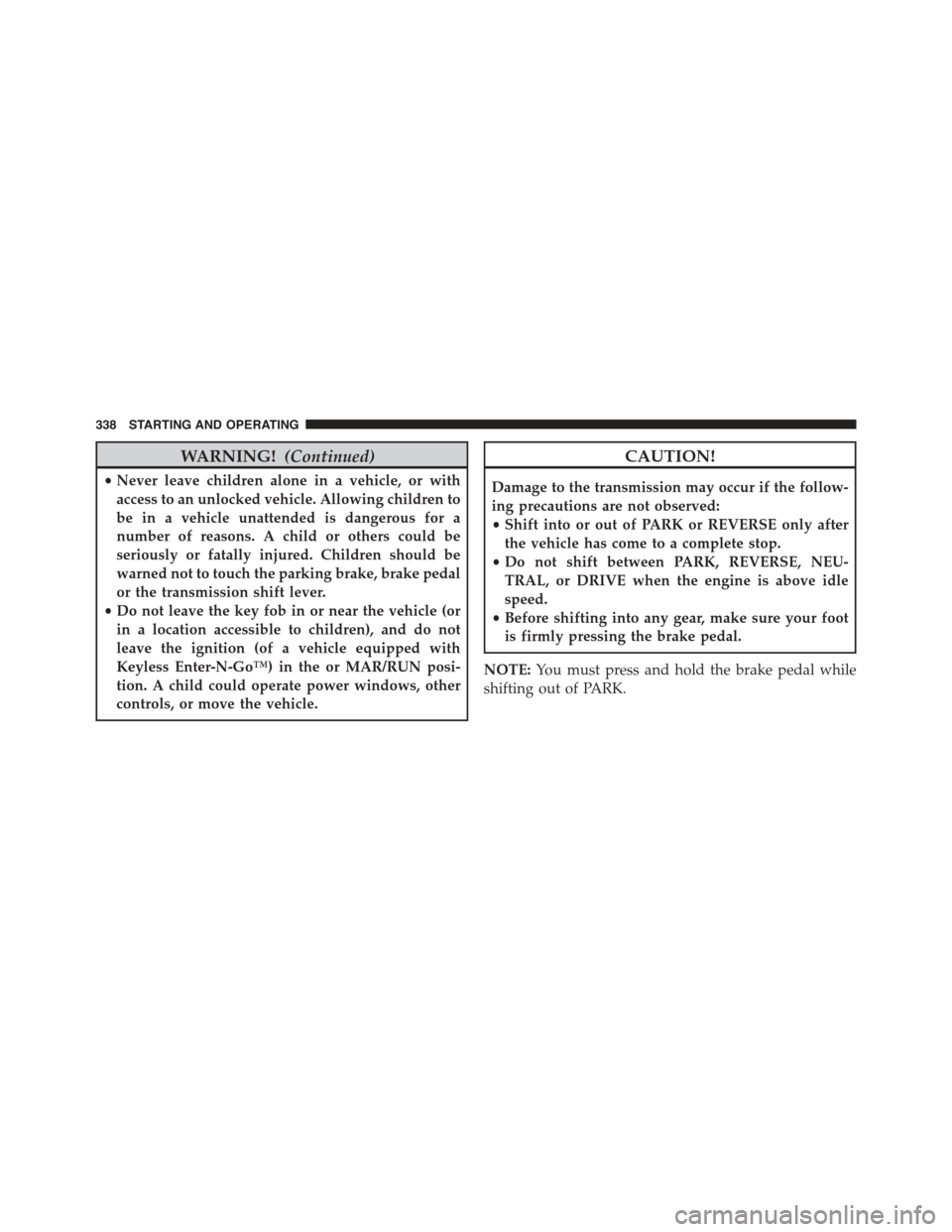
WARNING!(Continued)
•Never leave children alone in a vehicle, or with
access to an unlocked vehicle. Allowing children to
be in a vehicle unattended is dangerous for a
number of reasons. A child or others could be
seriously or fatally injured. Children should be
warned not to touch the parking brake, brake pedal
or the transmission shift lever.
•Do not leave the key fob in or near the vehicle (or
in a location accessible to children), and do not
leave the ignition (of a vehicle equipped with
Keyless Enter-N-Go™) in the or MAR/RUN posi-
tion. A child could operate power windows, other
controls, or move the vehicle.
CAUTION!
Damage to the transmission may occur if the follow-
ing precautions are not observed:
•Shift into or out of PARK or REVERSE only after
the vehicle has come to a complete stop.
•Do not shift between PARK, REVERSE, NEU-
TRAL, or DRIVE when the engine is above idle
speed.
•Before shifting into any gear, make sure your foot
is firmly pressing the brake pedal.
NOTE:You must press and hold the brake pedal while
shifting out of PARK.
338 STARTING AND OPERATING